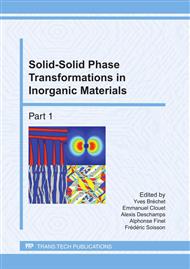p.857
p.863
p.869
p.875
p.881
p.887
p.893
p.899
p.905
Finite Element Simulation and Optimisation of Ageing Precipitation in Nickel Base Superalloys with a Low Gamma-Prime (g’) Volume Fraction
Abstract:
A finite element approach is used to simulate the precipitation of Ni3(Al,Ti) intermetallics in nickel-based superalloys containing a low volume fraction of spherical g’ precipitates, in which precipitation occurs following nucleation and growth mechanisms. Classical differential equations of nucleation and growth are implemented in the software Comsol (formerly Femlab), to compute the number of precipitates per unit volume and their mean size. Another originality of the model is the use of thermodynamic quantities coming from phase diagram computations (Thermo-Calc), like the temperature variation of the equilibrium g’ volume fraction, and the evolution of the concentration of g’ forming elements (Al, Ti) in the matrix with the volume fraction of precipitates. Once adjusted to experiment in the case of isothermal ageings, the model can be used to simulate precipitation during complex thermal histories. Finally, automatic heat treatment optimisation procedures are proposed and tested, which can reduce heat treatment times by a factor of more than five.
Info:
Periodical:
Pages:
881-886
Citation:
Online since:
June 2011
Price:
Сopyright:
© 2011 Trans Tech Publications Ltd. All Rights Reserved
Share:
Citation:


